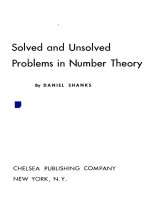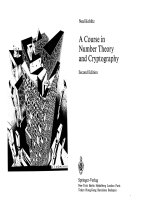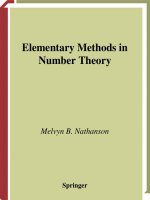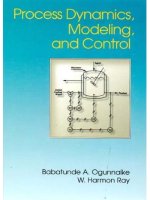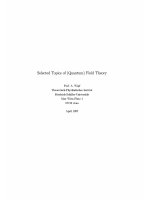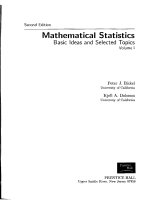ProblemSolving and Selected Topics in Number Theory
Bạn đang xem bản rút gọn của tài liệu. Xem và tải ngay bản đầy đủ của tài liệu tại đây (1.75 MB, 341 trang )
Problem-Solving and Selected Topics
in Number Theory
Michael Th. Rassias
Problem-Solving
and Selected Topics
in Number Theory
In the Spirit of the Mathematical Olympiads
(
Foreword by Preda Mihailescu
Michael Th. Rassias
Department of Pure Mathematics
and Mathematical Statistics
University of Cambridge
Cambridge CB3 0WB, UK
ISBN 978-1-4419-0494-2
e-ISBN 978-1-4419-0495-9
DOI 10.1007/978-1-4419-0495-9
Springer New York Dordrecht Heidelberg London
Mathematics Subject Classification (2010): 11-XX, 00A07
© Springer Science+Business Media, LLC 2011
All rights reserved. This work may not be translated or copied in whole or in part without the written
permission of the publisher (Springer Science+Business Media, LLC, 233 Spring Street, New York, NY
10013, USA), except for brief excerpts in connection with reviews or scholarly analysis. Use in connection
with any form of information storage and retrieval, electronic adaptation, computer software, or by similar
or dissimilar methodology now known or hereafter developed is forbidden.
The use in this publication of trade names, trademarks, service marks, and similar terms, even if they are
not identified as such, is not to be taken as an expression of opinion as to whether or not they are subject
to proprietary rights.
Printed on acid-free paper
Springer is part of Springer Science+Business Media (www.springer.com)
To my father Themistocles
Contents
Foreword by Preda Mih˘
ailescu . . . . . . . . . . . . . . . . . . . . . . . . . . . . . . . . . ix
Acknowledgments . . . . . . . . . . . . . . . . . . . . . . . . . . . . . . . . . . . . . . . . . . . . . xv
1
Introduction . . . . . . . . . . . . . . . . . . . . . . . . . . . . . . . . . . . . . . . . . . . . . . .
1.1 Basic notions . . . . . . . . . . . . . . . . . . . . . . . . . . . . . . . . . . . . . . . . . . .
1.2 Basic methods to compute the greatest common divisor . . . . . .
1.2.1 The Euclidean algorithm . . . . . . . . . . . . . . . . . . . . . . . . . . .
1.2.2 Blankinship’s method . . . . . . . . . . . . . . . . . . . . . . . . . . . . . .
1.3 The fundamental theorem of arithmetic . . . . . . . . . . . . . . . . . . . .
1.4 Rational and irrational numbers . . . . . . . . . . . . . . . . . . . . . . . . . . .
1
1
4
5
5
6
8
2
Arithmetic functions . . . . . . . . . . . . . . . . . . . . . . . . . . . . . . . . . . . . . . .
2.1 Basic definitions . . . . . . . . . . . . . . . . . . . . . . . . . . . . . . . . . . . . . . . . .
2.2 The M¨
obius function . . . . . . . . . . . . . . . . . . . . . . . . . . . . . . . . . . . . .
2.3 The Euler function . . . . . . . . . . . . . . . . . . . . . . . . . . . . . . . . . . . . . .
2.4 The τ -function . . . . . . . . . . . . . . . . . . . . . . . . . . . . . . . . . . . . . . . . . .
2.5 The generalized σ-function . . . . . . . . . . . . . . . . . . . . . . . . . . . . . . . .
15
15
16
20
24
26
3
Perfect numbers, Fermat numbers . . . . . . . . . . . . . . . . . . . . . . . . .
3.1 Perfect numbers . . . . . . . . . . . . . . . . . . . . . . . . . . . . . . . . . . . . . . . . .
3.1.1 Related open problems . . . . . . . . . . . . . . . . . . . . . . . . . . . . .
3.2 Fermat numbers . . . . . . . . . . . . . . . . . . . . . . . . . . . . . . . . . . . . . . . . .
3.2.1 Some basic properties . . . . . . . . . . . . . . . . . . . . . . . . . . . . . .
29
29
31
32
32
4
Congruences . . . . . . . . . . . . . . . . . . . . . . . . . . . . . . . . . . . . . . . . . . . . . . . 37
4.1 Basic theorems . . . . . . . . . . . . . . . . . . . . . . . . . . . . . . . . . . . . . . . . . . 37
5
Quadratic residues . . . . . . . . . . . . . . . . . . . . . . . . . . . . . . . . . . . . . . . . . 51
5.1 Introduction . . . . . . . . . . . . . . . . . . . . . . . . . . . . . . . . . . . . . . . . . . . . 51
viii
Contents
5.2 Legendre’s symbol . . . . . . . . . . . . . . . . . . . . . . . . . . . . . . . . . . . . . . .
5.2.1 The law of quadratic reciprocity . . . . . . . . . . . . . . . . . . . . .
5.3 Jacobi’s symbol . . . . . . . . . . . . . . . . . . . . . . . . . . . . . . . . . . . . . . . . .
5.3.1 An application of the Jacobi symbol to cryptography . .
56
62
70
77
6
The π- and li-functions . . . . . . . . . . . . . . . . . . . . . . . . . . . . . . . . . . . . 79
6.1 Basic notions and historical remarks . . . . . . . . . . . . . . . . . . . . . . . 79
6.2 Open problems concerning prime numbers . . . . . . . . . . . . . . . . . . 82
7
The Riemann zeta function . . . . . . . . . . . . . . . . . . . . . . . . . . . . . . . .
7.1 Definition and Riemann’s paper . . . . . . . . . . . . . . . . . . . . . . . . . . .
7.2 Some basic properties of the ζ-function . . . . . . . . . . . . . . . . . . . . .
7.2.1 Applications . . . . . . . . . . . . . . . . . . . . . . . . . . . . . . . . . . . . . .
8
Dirichlet series . . . . . . . . . . . . . . . . . . . . . . . . . . . . . . . . . . . . . . . . . . . . 99
8.1 Basic notions . . . . . . . . . . . . . . . . . . . . . . . . . . . . . . . . . . . . . . . . . . . 99
9
Special topics . . . . . . . . . . . . . . . . . . . . . . . . . . . . . . . . . . . . . . . . . . . . . . 103
9.1 The harmonic series of prime numbers . . . . . . . . . . . . . . . . . . . . . 103
9.2 Lagrange’s four-square theorem . . . . . . . . . . . . . . . . . . . . . . . . . . . 112
9.3 Bertrand’s postulate . . . . . . . . . . . . . . . . . . . . . . . . . . . . . . . . . . . . . 120
9.4 An inequality for the π-function . . . . . . . . . . . . . . . . . . . . . . . . . . . 129
9.5 Some diophantine equations . . . . . . . . . . . . . . . . . . . . . . . . . . . . . . 137
9.6 Fermat’s two-square theorem . . . . . . . . . . . . . . . . . . . . . . . . . . . . . . 143
83
83
84
95
10 Problems . . . . . . . . . . . . . . . . . . . . . . . . . . . . . . . . . . . . . . . . . . . . . . . . . . 147
11 Solutions . . . . . . . . . . . . . . . . . . . . . . . . . . . . . . . . . . . . . . . . . . . . . . . . . . 163
12 Appendix . . . . . . . . . . . . . . . . . . . . . . . . . . . . . . . . . . . . . . . . . . . . . . . . . . 291
12.1 Prime number theorem . . . . . . . . . . . . . . . . . . . . . . . . . . . . . . . . . . . 291
12.2 A brief history of Fermat’s last theorem . . . . . . . . . . . . . . . . . . . . 306
12.3 Catalan’s conjecture . . . . . . . . . . . . . . . . . . . . . . . . . . . . . . . . . . . . . 310
References . . . . . . . . . . . . . . . . . . . . . . . . . . . . . . . . . . . . . . . . . . . . . . . . . . . . . 317
Index of Symbols . . . . . . . . . . . . . . . . . . . . . . . . . . . . . . . . . . . . . . . . . . . . . . 321
Index . . . . . . . . . . . . . . . . . . . . . . . . . . . . . . . . . . . . . . . . . . . . . . . . . . . . . . . . . . 323
Foreword
The International Mathematics Olympiad (IMO), in the last two decades,
has become an international institution with an impact in most countries
throughout the world, fostering young mathematical talent and promoting a
certain approach to complex, yet basic, mathematics. It lays the ground for
an open, unspecialized understanding of the field to those dedicated to this
ancient art.
The tradition of mathematical competitions is sometimes traced back to
national contests which were organized in some countries of central Europe
already at the beginning of the last century. It is very likely that a slight
variation of the understanding of mathematical competition would reveal even
more remote ancestors of the present IMO. It is, however, a fact that the
present tradition was born after World War II in a divided Europe when the
first IMO took place in Bucharest in 1959 among the countries of the Eastern
Block. As an urban legend would have it, it came about when a high school
mathematics teacher from a small Romanian town began to pursue his vision
for an organized event that would help improve the teaching of mathematics.
Since the early beginnings, mathematical competitions of the international
olympiad type have established their own style of problems, which do not
require wide mathematical background and are easy to state. These problems
are nevertheless difficult to solve and require imagination plus a high degree of
original thinking. The Olympiads have reached full maturity and worldwide
status in the last two decades. There are presently over 100 participating
countries.
Accordingly, quite a few collections of Olympiad problems have been
published by various major publishing houses. These collections include
problems from past olympic competitions or from among problems proposed
by various participating countries. Through their variety and required detail
of solution, the problems offer valuable training for young students and a
captivating source of challenges for the mathematically interested adult.
In the so-called Hall of Fame of the IMO, which includes numerous
presently famous mathematicians and several Fields medalists, one finds a
x
Foreword
list of the participants and results of former mathematical olympiads (see
[HF]). We find in the list of the participants for Greece, in the year 2003, the
name of Michael Th. Rassias. At the age of 15 at that time, he won a silver
medal and achieved the highest score on the Greek team. He was the first
Greek of such a young age in over a decade, to receive a silver medal. He is
the author of the present book: one more book of Olympiad Problems among
other similar beautiful books.
Every single collection adds its own accent and focus. The one at hand
has a few particular characteristics which make it unique among similar
problem books. While most of these books have been written by experienced
mathematicians after several decades of practicing their skills as a profession, Michael wrote this present book during his undergraduate years in the
Department of Electrical and Computer Engineering of the National Technical University of Athens. It is composed of some number theory fundamentals
and also includes some problems that he undertook while training for the
olympiads. He focused on problems of number theory, which was the field of
mathematics that began to capture his passion. It appears like a confession
of a young mathematician to students of his age, revealing to them some of
his preferred topics in number theory based on solutions of some particular
problems—most of which also appear in this collection. Michael does not limit
himself to just those particular problems. He also deals with topics in classical
number theory and provides extensive proofs of the results, which read like
“all the details a beginner would have liked to find in a book” but are often
omitted.
In this spirit, the book treats Legendre symbols and quadratic reciprocity,
the Bertrand Postulate, the Riemann ζ-function, the Prime Number Theorem,
arithmetic functions, diophantine equations, and more. It offers pleasant
reading for young people who are interested in mathematics. They will be
guided to an easy comprehension of some of the jewels of number theory. The
problems will offer them the possibility to sharpen their skills and to apply
the theory.
After an introduction of the principles, including Euclid’s proof of the
infinity of the set of prime numbers, follows a presentation of the extended
Euclidean algorithm in a simple matricial form known as the Blankinship
method. Unique factorization in the integers is presented in full detail, giving
thus the basics necessary for the proof of the same fact in principal ideal
domains. The next chapter deals with rational and irrational numbers and
supplies elegant comprehensive proofs of the irrationality of e and π, which
are a first taste of Rassias’s way of breaking down proofs in explicit, extended
steps.
The chapter on arithmetic functions presents, along with the definition of
the M¨obius μ and Euler φ functions, the various sums of divisors
da ,
σa (n) =
d|n
Foreword
xi
as well as nice proofs and applications that involve the M¨
obius inversion
formula. We find a historical note on M¨obius, which is the first of a sequence
of such notes by which the author adds a temporal and historical frame to
the mathematical material.
The third chapter is devoted to algebraic aspects, perfect numbers,
Mersenne and Fermat numbers, and an introduction to some open questions
related to these. The fourth deals with congruences, the Chinese Remainder
Theorem, and some results on the rings Z/(n · Z) in terms of congruences.
These results open the door to a large number of problems contained in the
second part of the book.
Chapter 5 treats the symbols of Legendre and Jacobi and gives Gauss’s first
geometric proof of the law of quadratic reciprocity. The algorithm of Solovay
and Strassen—which was the seminal work leading to a probabilistic perspective of fundamental notions of number theory, such as primality—is described
as an application of the Jacobi symbol. The next chapters are analytic, introducing the ζ and Dirichlet series. They lead to a proof of the Prime Number
Theorem, which is completed in the ninth chapter. The tenth and eleventh
chapters are, in fact, not only a smooth transition to the problem part of the
book, containing already numerous examples of solved problems, they also,
at the same time, lead up to some theorems. In the last two subsections of
the appendix, Michael discusses special cases of Fermat’s Last Theorem and
Catalan’s conjecture.
I could close this introduction with the presentation of my favorite problem,
but instead I shall present and briefly discuss another short problem which is
included in the present book. It is a conjecture that Michael Rassias conceived
of at the age of 14 and tested intensively on the computer before realizing its
intimate connection with other deep conjectures of analytic number theory.
These conjectures are still today considered as intractable.
Rassias Conjecture. For any prime p with p > 2 there are two primes p1 , p2 ,
with p1 < p2 such that
p 1 + p2 + 1
p=
.
(1)
p1
The conjecture was verified empirically on a computer and was published
along with a series of problems from international Olympiads (see [A]). The
purpose of this short note is to put this conjecture in its mathematical context
and relate it to further known conjectures.
At first glance, the expression (1) is utterly surprising and it could stand
for some unknown category of problems concerning representation of primes.
Let us, though, develop the fraction in (1):
(p − 1)p1 = p2 + 1.
Since p is an odd prime, we obtain the following slightly more general
conjecture: For all a ∈ N there are two primes p, q such that
xii
Foreword
2ap = q + 1.
(2)
Of course, if (2) admits a solution for any a ∈ N, then a fortiori (1) admits
a solution. Thus, the Rassias conjecture is true. The new question has the
particularity that it only asks to prove the existence of a single solution.
We note, however, that this question is related to some famous problems, in
which one asks more generally to show that there is an infinity of primes
verifying certain conditions.
For instance, the question if there is an infinity of Sophie Germain primes
p, i.e., primes such that 2p + 1 is also a prime, has a similar structure. While
in the version (2) of the Rassias conjecture, we have a free parameter a and
search for a pair (p, q), in the Sophie Germain problem we may consider p itself
as a parameter subject to the constraint that 2p + 1 is prime, too. The fact
that there is an infinity of Sophie Germain primes is an accepted conjecture,
and one expects the density of such primes to be O(x/ ln2 (x)) [Du]. We obtain
from this the modified Rassias conjecture by introducing a constant a as factor
of 2 and replacing +1 by −1. Thus q = 2p + 1 becomes q = 2ap − 1, which
is (2). Since a is a parameter, in this case we do not know whether there are
single solutions for each a. When a is fixed, this may of course be verified on
a computer or symbolically.
A further related problem is the one of Cunningham chains. Given two
coprime integers m, n, a Cunningham chain is a sequence p1 , p2 , . . . , pk of
primes such that pi+1 = mpi + n for i > 1. There are competitions for finding
the longest Cunningham chains, but we find no relevant conjectures related
to either length or frequencies of such chains. In relation to (2), one would
rather consider the Cunningham chains of fixed length 2 with m = 2a and
n = −1. So the question (2) reduces to the statement: there are Cunningham
chains of length two with parameters 2a, −1, for any a ∈ N.
By usual heuristic arguments, one should expect that (2) has an infinity
of solutions for every fixed a. The solutions are determined by one of p or q
via (2). Therefore, we may define
Sx = {p < ax : p is prime and verifies (2)}
and the counting function πr (x) = |Sx |. There are O(ln(x)) primes p < x, and
2ap − 1 is an odd integer belonging to the class −1 modulo 2a. Assuming that
the primes are equidistributed in the residue classes modulo 2a, we obtain the
expected estimate:
πr (x) ∼ x/ ln2 (x)
(3)
for the density of solutions to the extended conjecture (2) of Rassias.
Probably the most general conjecture on distribution of prime constellations is Schinzel’s Conjecture H :
Conjecture H. Consider s polynomials fi (x) ∈ Z[X], i = 1, 2, . . . , s with posis
tive leading coefficients and such that the product F (X) = i=1 fi (x) is not
Foreword
xiii
divisible, as a polynomial, by any integer different from ±1. Then there is at
least one integer x for which all the polynomials fi (x) take prime values.
Of course, the Rassias conjecture follows for s = 2 with f1 (x) = x and
f2 (x) = 2ax − 1. Let us finally consider the initial problem. Can one prove
that (2) has at least one solution in primes p, q, for arbitrary a? In [SW],
Schinzel and Sierpi´
nski show that Conjecture H can be stated for one value of
x or for infinitely many values of x, since the two statements are equivalent.
Therefore, solving the conjecture of Rassias is as difficult as showing that
there are infinitely many prime pairs verifying (2). Of course, this does not
exclude the possibility that the conjecture could be proved easier for certain
particular families of values of the parameter a.
The book is self-contained and rigorously presented. Various aspects of
it should be of interest to graduate and undergraduate students in number
theory, high school students and the teachers who train them for the Putnam
Mathematics Competition and Mathematical Olympiads as well as, naturally,
to scholars who enjoy learning more about number theory.
Bibliography
[A] T Andreescu and D. Andrica, Number Theory, Birkh¨
auser, Boston,
(2009), p. 12.
[Du] H Dubner, Large Sophie-Germain primes, Math. Comp., 65(1996),
pp. 393–396.
[HF] -official.org/country− hall.aspx?code=HEL
[R] Michael Th. Rassias, Open Problem No. 1825, Octogon Mathematical
Magazine, 13(2005), p. 885. See also Problem 25, Newsletter of the
European Mathematical Society, 65(2007), p. 47.
[SW] A Schinzel and W. Sierpi´
nski, Sur certaines hypoth`eses concernant les
nombres premiers, Acta Arith., 4(1958), pp. 185–208.
Preda Mih˘ailescu
Mathematics Institute
University of G¨
ottingen
Germany
Acknowledgments
I wish to express my gratitude to Professors A. Papaioannou and
V. Papanicolaou for their invaluable assistance and inspirational guidance,
both during my studies at the National Technical University of Athens and
the preparation of this book.
I feel deeply honored that I had the opportunity to communicate with
Professor Preda Mih˘
ailescu, who has been my mentor in Mathematics since
my high school years and has written the Foreword of the book.
I would like to thank Professors M. Filaseta, S. Konyagin, V. Papanicolaou
and J. Sarantopoulos for their very helpful comments concerning the step-bystep analysis of Newman’s proof of the Prime Number Theorem. Professor
P. Pardalos has my special appreciation for his valuable advice and encouragement. I would like to offer my sincere thanks to Professors K. Drakakis,
J. Kioustelidis, V. Protassov and J. Sandor for reading the manuscript and
providing valuable suggestions and comments which have helped to improve
the presentation of the book.
This book is essentially based on my undergraduate thesis on computational number theory, which I wrote under the supervision of Professors
A. Papaioannou, V. Papanicolaou and C. Papaodysseus at the National Technical University of Athens. I have added a large number of problems with their
solutions and some supplementary number theory on special topics.
I would like to express my thanks to my teachers for their generous advice
and encouragement during my training for the Mathematical Olympiads and
throughout my studies.
Finally, it is my pleasure to acknowledge the superb assistance provided
by the staff of Springer for the publication of the book.
Michael Th. Rassias
1
Introduction
God created the natural numbers. The rest is the work of man.
Leopold Kronecker (1823–1891)
Number Theory is one of the most ancient and active branches of pure mathematics. It is mainly concerned with the properties of integers and rational
numbers. In recent decades, number theoretic methods are also being used
in several areas of applied mathematics, such as cryptography and coding
theory.
In this section, we shall present some basic definitions, such as the definition of a prime number, composite number, rational number, etc. In addition,
we shall present some basic theorems.
1.1 Basic notions
Definition 1.1.1. An integer p greater than 1 is called a prime number, if
and only if it has no positive divisors other than 1 and itself.
Hence, for example, the integers 2, 3, 13, 17 are prime numbers, but 4, 8, 12,
15, 18, 21 are not.
The natural number 1 is not considered to be a prime number.
Definition 1.1.2. All integers greater than one which are not prime numbers
are called composite numbers.
Definition 1.1.3. Two integers a and b are called relatively prime or
coprime if and only if there does not exist another integer c greater than
1, which can divide both a and b.
For example, the integers 12 and 17 are relatively prime.
M.Th. Rassias, Problem-Solving and Selected Topics in Number Theory: In the Spirit
of the Mathematical Olympiads, DOI 10.1007/978-1-4419-0495-9_1,
© Springer Science +Business Media, LLC 2011
1
2
1 Introduction
Prime numbers are, in a sense, the building blocks with which one can
construct all integers. At the end of this chapter we are going to prove the
Fundamental Theorem of Arithmetic according to which every natural number
greater than one can be represented as the product of powers of prime numbers
in a unique way.
This theorem was used by the ancient Greek mathematician Euclid, in
order to prove that prime numbers are infinitely many.
We shall now present the proof of the fact that the number of primes is
infinite. The following proof is due to Euclid and is considered to be one of
the most elementary and elegant proofs of this theorem.
Lemma 1.1.4. The least nontrivial divisor of every positive integer greater
than 1 is a prime number.
Proof. Let n ∈ N, with n > 1 and d0 be the least nontrivial divisor of n.
Let us also suppose that d0 is a composite positive integer. Then, since d0 is
composite, it must have a divisor m, with 1 < m < d0 . But, in that case, m
would also divide n and therefore d0 would not be the least nontrivial divisor
of n. That contradicts our hypothesis and hence completes the proof of the
lemma.
✷
Theorem 1.1.5 (Euclid). The number of primes is infinite.
Proof. Let us suppose that the number of primes is finite and let p be the
greatest prime number. We consider the integer
Q = p! + 1.
Therefore, if Q is a prime number it must be greater than p. But, this contradicts the property of p being the greatest prime number. On the other hand,
if Q is not a prime number, then by the previous lemma it follows that it will
certainly have prime divisors. However, if Q is divided by any prime number
less than or equal to p, it leaves remainder 1. Thus, every prime divisor of Q
is necessarily greater than p, which again contradicts the property of p.
So, the hypothesis that the number of primes is finite, leads to a contradiction. Hence, the number of primes is infinite.
✷
We shall now proceed to the proof of a theorem which is known as
Bezout’s Lemma or the extended Euclidean algorithm.
Theorem 1.1.6. Let a, b ∈ Z, where at least one of these integers is different
than zero. If d is the greatest positive integer with the property d | a and d | b,
then there exist x, y ∈ Z such that d = ax + by.
Proof. Let us consider the nonempty set
A = {ax + by | a, b, x, y ∈ Z, with ax + by > 0}.
We shall prove that the integer d is the least element in A.
1.1 Basic notions
3
Let d be the least element in A. Then, there exist integers q, r, such that
a = d q + r, 0 ≤ r < d.
We are going to prove that d | a. In other words, we will show that r = 0.
Let r = 0, then
r = a − d q = a − (ax1 + by1 )q,
for some integers x1 , y1 .
Therefore,
r = a(1 − x1 q) + b(−y1 q).
But, by the assumption we know that r = 0. Hence, it is evident that r > 0
and r = ax2 + by2 , with x2 = 1 − x1 , y2 = −y1 q ∈ Z. However, this is
impossible due to the assumption that d is the least element in A. Thus,
r = 0, which means that d | a. Similarly, we can prove that d | b.
So, d is a common divisor of a and b. We shall now prove that d is the
greatest positive integer with that property.
Let m be a common divisor of a and b. Then m|ax + ay and thus m | d ,
from which it follows that m ≤ d . Consequently, we obtain that
d = d = ax + by, for x, y ∈ Z.
✷
Remark 1.1.7. The positive integer d with the property stated in the above
theorem is unique. This happens because if there were two positive integers
with that property, then it should hold d1 ≤ d2 and d2 ≤ d1 . Thus, d1 = d2 .
As a consequence of the above theorem we obtain the following corollary.
Corollary 1.1.8. For every integer e with e | a and e | b, it follows that e | d.
Definition 1.1.9. Let a, b ∈ Z, where at least one of these integers is nonzero.
An integer d > 0 is called the greatest common divisor of a and b (and
we write d=gcd(a, b)) if and only if d | a and d | b and for every other positive
integer e for which e | a and e | b it follows that e | d.1
Theorem 1.1.10. Let d = gcd(a1 , a2 , . . . , an ), where a1 , a2 , . . . , an ∈ Z. Then
gcd
an
a1 a2
, ,...,
d d
d
= 1.
Proof. It is evident that d | a1 , d | a2 , . . . , d | an . Hence,
a1 = k1 d, a2 = k2 d, . . . , an = kn d,
1
(1)
Similarly one can define the greatest common divisor of n integers, where at least
one of them is different than zero.
4
1 Introduction
where ki ∈ Z for i = 1, 2, . . . , n. Let
an
a1 a 2
, ,...,
d d
d
= d > 1.
Then, similarly we obtain
d |
a1
a2
an
,d | ,...,d |
.
d
d
d
Consequently, there exist integers k1 , k2 , . . . , kn , for which
a1
a2
an
= k1 d ,
= k2 d , . . . ,
= kn d .
d
d
d
(2)
Therefore, by (1) and (2) we get
a1 = k1 d d, a2 = k2 d d, . . . , an = kn d d.
Thus,
d d | a1 , d d | a2 , . . . , d d | an .
Hence, dd | d, which is impossible since d > 1. Therefore, d = 1.
✷
Theorem 1.1.11. Let a, b, c ∈ Z and a | bc. If gcd(a, b) = 1, then a | c.
Proof. If gcd(a, b) = 1, then
1 = ax + by, where x, y ∈ Z.
Therefore,
c = acx + bcy.
But, since a | acx and a | bcy, it yields a | c.
✷
1.2 Basic methods to compute the greatest common
divisor
Let a, b ∈ Z. One way to compute the greatest common divisor of a and b is
to find the least element in the set
A = {ax + by | a, b, x, y ∈ Z, with ax + by > 0}.
However, there is a much more effective method to compute gcd(a, b) and is
known as the Euclidean algorithm.
1.2 Basic methods to compute the greatest common divisor
5
1.2.1 The Euclidean algorithm
In case we want to compute the gcd(a, b), without loss of generality we can
suppose that b ≤ a. Then gcd(a, b) = gcd(b, r), with r being the remainder
when a is divided by b.
This happens because a = bq + r or r = a − bq, for some integer q and
therefore gcd(a, b) | r. In addition, gcd(a, b) | b. Thus, by the definition of the
greatest common divisor, we obtain
gcd(a, b) | gcd(b, r).
(1)
Similarly, since a = bq + r, we get gcd(b, r) | b and gcd(b, r) | a. Hence,
gcd(b, r) | gcd(a, b).
(2)
By (1) and (2) it is evident that gcd(a, b) = gcd(b, r).
If b = a, then gcd(a, b) = gcd(a, 0) = gcd(b, 0) = a = b and the algorithm
terminates. However, generally we have
gcd(a, b) = gcd(b, r1 ) = gcd(r1 , r2 ) = · · · = gcd(rn−1 , rn ) = gcd(rn , 0) = rn ,
with
a = bq1 + r1 , because b ≤ a
b = r1 q2 + r2 , because 0 ≤ r1 < b
r1 = r2 q3 + r3 , because 0 ≤ r2 < r1
..
.
rn−2 = rn−1 qn + rn , because 0 ≤ rn−1 < rn
rn−1 = rn qn+1 + 0, because 0 ≤ rn < rn−1 .
Therefore, rn is the greatest common divisor of a and b.
1.2.2 Blankinship’s method
Blankinship’s method is a very practical way to compute the greatest common
divisor of two integers a and b. Without loss of generality, let us suppose that
a > b > 0. Then, the idea of this method is the following. Set
A=
a
b
1
0
0
1
.
By doing row operations we try to transform A, so that it takes the form
d x
0 x
y
y
or
0 x
d x
y
y
6
1 Introduction
In other words, we try to transform A so that it has a zero element in its
first column. Then, gcd(a, b) = d, as it appears in the first column of the
transformed matrix. More specifically, we have
d = ax + by.
Hence, by the above argument, it follows that by Blankinship’s method, not
only can we compute gcd(a, b), but also the coefficients x, y, which appear in
Bezout’s Lemma.
EXAMPLE 1.2.1. Compute the greatest common divisor of the integers 414
and 621.
Consider the matrix
A=
621 1 0
414 0 1
.
Let Ri be the ith row of A. We substitute R1 with R1 − R2 and we get
A∼
207 1
414 0
−1
1
.
Furthermore, if we substitute R2 with R2 − 2R1 , we get
A∼
207 1 −1
0 −2 3
.
Hence, we succeeded to transform A so that it has a zero element in its first
column. Therefore, we obtain that gcd(414, 621) = 207 and more specifically
207 = 621 · 1 + 414 · (−1).
✷
1.3 The fundamental theorem of arithmetic
Theorem 1.3.1 (Euclid’s First Theorem). Let p be a prime number and
a, b ∈ Z. If p | ab, then
p | a or p | b.
Proof. Let us suppose that p does not divide a. Then, it is evident that
gcd(a, p) = 1 and by Bezout’s Lemma we have 1 = ax + py and thus
b = abx + pby, where x, y ∈ Z. But, p | abx and p | pby. Therefore, p | b.
Similarly, if p does not divide b, we can prove that p | a. Hence, p | a or
p | b.
✷
Theorem 1.3.2 (The Fundamental Theorem of Arithmetic). Every
positive integer greater than 1 can be represented as the product of powers
of prime numbers in a unique way.
1.3 The fundamental theorem of arithmetic
7
Proof.
Step 1. We shall prove that every positive integer n > 1 can be represented
as the product of prime numbers.
If d is a divisor of n, then 1 < d ≤ n. Of course, if n is a prime number,
then n = d and the theorem holds true. On the other hand, if n is a composite
integer, then it obviously has a least divisor d0 > 1. But, by the above lemma
we know that the least nontrivial divisor of every integer is always a prime
number. Hence, d0 is a prime number and there exists a positive integer n1
for which it holds
n = d0 n1 .
Similarly, the positive integer n1 has a least nontrivial divisor d2 which must
be prime. Therefore, there exists another positive integer n2 , for which
n = d1 d2 n2 .
If we continue the same process, it is evident that n can be represented as the
product of prime numbers. Furthermore, because of the fact that some prime
numbers may appear more than once in this product, we can represent n as
the product of powers of distinct primes. Namely,
n = pa1 1 pa2 2 · · · pakk , where k ∈ N.
The above form of representation of a positive integer n is called the canonical
or standard form of n.
Step 2. We shall now prove that the canonical form is unique.
Let us suppose that the positive integer n can be represented as the
product of powers of prime numbers in two different ways. Namely,
n = pa1 1 pa2 2 · · · pakk = q1b1 q2b2 · · · qλbλ , where k, λ ∈ N.
Then, by Euclid’s first theorem, we obtain
pi | pa1 1 pa2 2 · · · pakk
which yields
pi | q1b1 q2b2 · · · qλbλ
and therefore, for every i, with 1 < i < k, there exists a j, with 1 < j < λ
for which pi | qj and thus pi = qj . Thus, it is clear that k = λ and the sets
{p1 , p2 , . . . , pk }, {q1 , q2 , . . . , qλ } are identical.
Hence, it suffices to prove that
ai = b i ,
for every i, where i = 1, 2, . . . , k = λ. Let us suppose that ai > bi . Then, we
have
8
1 Introduction
pa1 1 pa2 2 · · · pai i · · · pakk = q1b1 q2b2 · · · qibi · · · qkbk
= pb11 pb22 · · · pbi i · · · pbkk .
Thus,
i−1
i+1
pa1 1 pa2 2 · · · pai i −bi · · · pakk = pb11 pb22 · · · pi−1
pi+1
· · · pbkk .
b
b
(1)
But, ai − bi ≥ 1 and therefore by (1) we obtain
pi | pa1 1 pa2 2 · · · pakk and pi |pb11 pb22 · · · pbkk ,
which is a contradiction.
Similarly, we are led to a contradiction in the case ai < bi . Therefore, it is
evident that ai = bi must hold true for every i = 1, 2, . . . , k. This completes
the proof.
✷
Definition 1.3.3. A positive integer n is said to be squarefree, if and only
if it cannot be divided by the square of any prime number.
Lemma 1.3.4. Every positive integer n can be represented in a unique way
as the product a2 b of two integers a, b, where b is a squarefree integer.
Proof. Since for n = 1 the lemma obviously holds true, we suppose that
n > 1. By the Fundamental Theorem of Arithmetic we know that every
positive integer greater than 1 can be represented as the product of powers of
prime numbers in a unique way. Therefore, we have
n = pa1 1 pa2 2 · · · pakk , where n ∈ N.
Let us consider the set A = {a1 , a2 , . . . , ak }. If mi are the even integers in A
and hi are the odd integers in A, then clearly we have
h
mλ
h1 h2
μ
1 m2
n = (pm
i1 pi2 · · · piλ )(pj1 pj2 · · · pjμ )
2f +1
2f1 +1 2f2 +1
2eλ
1 2e2
= (p2e
pj2
· · · pjμ μ
i1 pi2 · · · piλ )(pj1
)
f
= (pei11 pei22 · · · peiλλ · pfj11 pfj22 · · · pjμμ )2 · (pj1 · · · pjμ )
= a2 · b.
The integers pi , qi are unique and thus the integers mi , hj are unique. Hence,
the integers a and b are unique.
✷
1.4 Rational and irrational numbers
Definition 1.4.1. Any number that can be expressed as the quotient p/q of
two integers p and q, where q = 0, is called a rational number.


